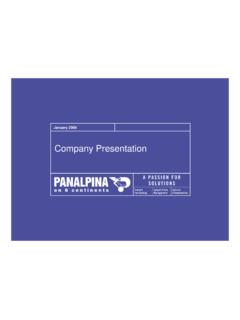Transcription of 3596 SSLD partitions AW 2/5/07 11:35 Page i
1 partitions in schoolsStandard specifications, layouts and dimensionsONE3596_SSLD_partitions_AW 2/5/07 11:35 Page iWe are grateful to the following individuals and organisations that have contributed to the production of this guidance:Richard Parker, lead author, AMEC Design & Project ServicesDavid Hammond, AMEC Design & Project ServicesDave Clarke, Sound Research LaboratoriesIan Morris, Atkins Mark Cleverly, EC Harris, Cost ConsultantsBecker Sliding PartitionsBritish GypsumXella Dry lining SystemsTarmac Topblock IAC Troax Lee ManufacturingGezeUnilock ProductsPoole PartitioningDorma UKWe are also grateful to the following membersof the Standard Specifications, Layouts andDimensions ( ssld )
2 Forum who have helpedshape the broad approach to standardisation in this and other guidance documents in this series:Mukund Patel, DfES ( ssld Forum Chair)Alan Jones, DfES ( ssld Policy Lead)Ian Morris, Atkins ( ssld Project Manager)Beech Williamson, Partnerships for SchoolsStephen Reffitt, AtkinsMark Cleverly, EC HarrisPaul Foster, EC HarrisMich l Cohen, Walters and Cohen, ArchitectsKaren Rogers, Walters and Cohen, ArchitectsChristian Held, Penoyre and Prasad ArchitectsSunand Prasad, Penoyre and Prasad Architects Linton Ross, Feilden Clegg Bradley ArchitectsPeter Clegg, Feilden Clegg Bradley ArchitectsPaul Hetherington, Alumasc Interiors LtdRichard Parker, AMEC Design and project servicesAndrew Williams, BREBill Healy, Build OffsiteRichard Ogden, Build OffsiteMike Entwisle.
3 Buro HappoldRita Singh, Construction Products AssociationMichael Ankers, Construction ProductsAssociationBea Etayo, Fulcrum ConsultingPeter Blunt, Mtech GroupMartin Goss, Mtech GroupDavid Mackness, SCAPE System Build LtdMartin Lipson, 4 PsMairi Johnson, CABER ichard Saxon, CBEP eter Woolliscroft, OGCR ichard Brindley, RIBAVic Ebdon, Devon County CouncilDon Bryson, DBS ConsultancyKevin Kendall, Nottinghamshire County CouncilSui Te Wu, Southwark Borough CouncilAcknowledgements3596_SSLD_partiti ons_AW 2/5/07 11:35 Page iiPartitions in schools1 Contents1 Introduction2 Who this guidance is for2 How the guidance should be used2 Background to Standard Specifications, Layouts and Dimensions ( ssld ) 4 Aims and scope of this guidance52 Key performance requirements6 Structural performance6 Fire safety9 Acoustic performance12 Surface finishes15 Durability and adaptability16 Health and safety17 Sustainability18 Moveable partitions18 Material sizes19 Cost comment19 Capital costs19 Whole-life costs203 Performance specifications and some design examples21 Partition wall types.
4 Summary22 Partition wall type A24 Partition wall type B26 Partition wall type C28 Partition wall type D30 Partition wall type E32 Partition finishes: summary34 Partition finish type F136 Partition finish type F238 Partition finish type F3404 References423596_SSLD_partitions_AW 2/5/07 11:35 Page 12 Standard specifications, layouts and dimensionsIntroductionThis guidance is one of a series of Standard Specifications, Layouts and Dimensions ( ssld ) guidance notes produced to inform the Building Schools for the Future (BSF) this guidance is for Teachers and governors acting as clients for school capital projects Local authority officers responsible forprocuring school capital projects Diocesan building officers Local authority and private sector school designers and specifiers Manufacturers and suppliers Contractors How the guidance should be usedThis guidance sets out the standards ofperformance for internal partitions in schools in the Building Schools for the Future (BSF)programme and shows how they might bedelivered through some design examples.
5 The aim is to disseminate best practice andavoid reinventing the wheel every time aschool building is designed, so that consistentlyhigh quality environments can be delivered,offering best whole-life value for 2/5/07 11:35 Page 2 partitions in schools3 School building clients, their professional advisers,contractors and their supply chains should usethe guidance to inform their decisions on internalpartitions and specification standards at the earlystages of a project s development whether thatbe new build, extension or refurbishment at RIBA Stages help encourage the take up of theseperformance specifications and designexamples.
6 This guidance will become thestandard in BSF programme documentationand the Government will expect it to beadopted in the majority of situations, where it isreasonable and appropriate to do so. While wewould expect projects to comply with thestandards, other solutions possibly based onnew products or technologies, or reflecting local factors may equally comply with theperformance specification and could be do not want to stifle innovation by beingtoo prescriptive. It is for users to exercise their own skill and expertise in deciding whether a solutionshown in this publication is reasonable and appropriate for their circumstances.
7 The guidance here does not affect obligationsand liabilities under the law relating toconstruction and 2/5/07 11:35 Page 34 Standard specifications, layouts and dimensionsThough principally aimed at secondary schoolbuilding projects delivered through the BSFprogramme, the specifications and solutionsmay also apply to other educational will keep this guidance under review and update it as necessary to reflect thedevelopment of new products, processes, andregulations. A web-based version is available Background to Standard Specifications,Layouts and Dimensions ( ssld ) The BSF programme offers a uniqueopportunity over the next 10-15 years totransform our secondary schools, providinginnovative learning environments that willinspire pupils to achieve more.
8 High quality,modern school buildings will help to raise standards and play a crucial part in the Government s programme of educational the huge increases in funding associatedwith this programme, there is considerablescope for using standardised specifications,layouts and dimensions to speed up design and construction, reduce whole-life costs anddeliver consistently high quality and bettervalue school buildings. Standardisation willsupport the use of more off-site fabrication andmodern methods of construction, which shouldhelp to improve heath and safety performance,reduce waste and deliver more sustainablesolutions.
9 For the supply industry, beinginvolved in standardisation will help todemonstrate market leadership and help firmsreduce risk and increase sales, profitability, andmarket solutions presented in this publicationand the others in the ssld series have beendeveloped based on extensive consultationunder the auspices of the ssld Forum. Set upby the Department for Education and Skills(DfES), this forum represents key stakeholdersin the building, design, research, contracting,and supply communities, as well as localauthority construction clients. 3596_SSLD_partitions_AW 2/5/07 11:35 Page 4 partitions in schools5 Aims and scope of this guidanceThis publication provides a standardperformance specification and some design examples for non load-bearing internal partitions , including their components,assemblies and finishes.
10 It offers designguidance for project designers formulating thetechnical specifications, specifically setting outminimum standards of performance and qualityexpected by the DfES. It standardises partitiontypes so that efficiencies and economies ofscale can be generated within the supply chain. It aims to make it easier for caretakersand facilities managers to maintain, repair andreplace components publication is structured as follows: Section 2:The generic performancecharacteristics of internal partitions and their finishes in secondary schools. Section 3:Performance specifications forpartitions and their finishes in differentlocations within a building, together with anumber of design examples that meet theperformance requirements.

